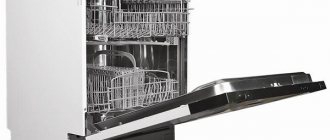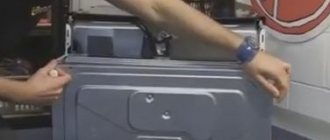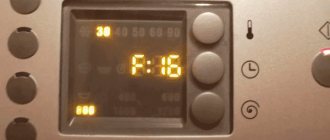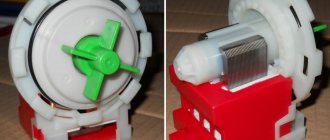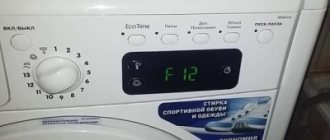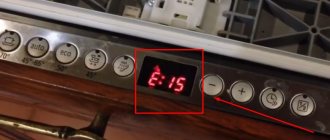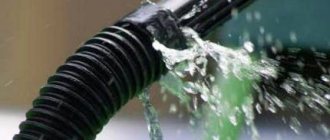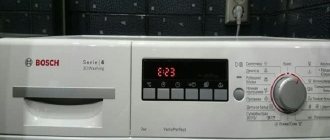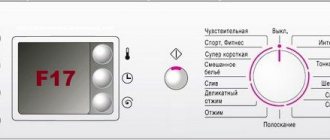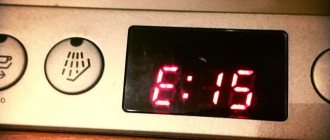Kron dishwashers are reliable, practical and economical, so it is not surprising that many consumers give them their preference. When a part or functioning system of Krona dishwashers fails, an error code appears on the display indicating a specific malfunction or a series of breakdowns. For example, an E1 error may appear at any time in a Krona dishwasher, which can be corrected by restarting the device or carrying out a quality repair.
Characteristics
Model series
| Series | AQUA Stop |
| Energy efficiency class | A |
| Energy consumption per cycle | 0.74 kWh |
| Water consumption per cycle | 13 l |
dimensions
| Overall dimensions (H*W*D) | 820*445*550 cm |
| Niche size (H*W*D) | 820*450*580 mm |
Loading
| Maximum capacity | 8 sets |
Noise level
| Noise level | 53 dB |
Control
| Control type | electronic |
Functions
| Number of washing programs | 7 |
| Accelerated washing program | Yes |
| Washing thin glass | Yes |
| "Partial load" mode | Yes |
| Hot water rinse mode | Yes |
| Preliminary rinsing | Yes |
| Delayed start | up to 24 hours |
Advantages and disadvantages
The advantages of PMM Krona BDE 4507 include:
- low price;
- availability of special programs;
- easy to install and operate.
According to user reviews, the device has a large number of disadvantages, which include:
- poor washing quality when using short programs;
- short service life of some parts;
- high noise level;
- high water consumption;
- inability to use combined detergents.
Indication
| Ind. time until the end of the program | Yes |
| Operating mode indication | Yes |
Internal equipment
| Box height adjustment | Yes |
| Folding plate holders | Yes |
Security systems
| Leak protection | full |
| Name leak protection | AquaStop |
| Self-diagnosis is faulty. | Yes |
Equipment
| Basket for table. devices | Yes |
| Funnel for filling. salt | Yes |
Similar models
The following Krona brand PMMs have similar characteristics:
- BDE 6007 EU. Full-size model, designed to wash 12 sets of dishes. The machine is suitable for installation in houses with large kitchen areas. In 1 cycle, the device consumes up to 16 liters of water. The functionality includes 7 programs, including delicate washing, pre-soaking and quick mode. Complete protection against leaks helps prevent emergency situations from depressurizing the housing. Disadvantages include high noise levels, lack of child protection and automatic water hardness adjustment.
- BDE 4507 LP. Compact machine, holds up to 9 place settings. The device is equipped with an automatic fault diagnosis system and complete protection against leaks. It differs from the previous model in lower energy consumption and water consumption. The functionality includes 4 main programs, including pre-soaking, intensive washing and short cycle. When washing dishes with this device, you can use combination detergents.
- BDX 45096 HT. A narrow dishwasher with a high energy efficiency class and economical water consumption. The user is offered 6 programs and 4 temperature modes, from which you can select a function appropriate to the type and soiling of the dishes. The ability to change the height of the upper basket makes loading easier. The set includes plate holders and a tray for kitchen utensils. The device is equipped with the Aquastop system and automatic error diagnosis.
- BDX 60126 HT. Fully built-in PMM, holds up to 12 sets of dishes. The device is equipped with a glass holder and a height-adjustable basket. The budget model has only the necessary programs and functions, including a delay timer and leakage protection. The camera is made of high quality steel. Partial loading mode allows you to avoid accumulating dirty dishes. Disadvantages include low quality replacement parts and high noise levels.
Connection
| Power consumption | 1760 W |
How to use
According to the instructions for use of PMM Krona, installation and operation of the device includes the following steps:
- Connection to communication systems. When choosing where to install the machine, you need to take into account the distance to the water and sewer pipes. The connection is made by tapping into the pipe and installing an adapter. All connections must be tight. To connect to the power supply network, install a socket near the installation site.
- Preparing for work. According to the manual for Aquastop BDE 4507 EU, salt and rinse aid must be added before the first use. The dishes are loaded so that they do not interfere with the movement of the sprinklers.
- Selecting a program and starting the device. After pressing the power button, use the keys located on the control panel to select the desired function. Detergent is added to a special compartment. After pressing the “Start” button, the machine begins the washing cycle. You can open the door and remove dishes only after the sound signal appears.
Color and weight
| Control panel color | grey |
| Weight | 33 kg |
Debugg
You have loaded the dishes and started the wash cycle. Water began to flow through the pipes, but did not get inside, or only a small amount accumulated. What to do, how to fix the problem?
Mechanical obstacles to water flow
First, it’s worth checking whether water has gotten into the device at all—there should be at least a small supply of it at the bottom. The program begins by draining the water remaining from the previous job. Filling a new one will begin only after this operation. The valve can be thought of as a faucet on a dishwasher that does not let water flow. It could also be a clogged filter on the valve.
Valve filter
Leakage protection triggered
Krona equipment has unusual inlet hoses. These are Aquastop hoses for a dishwasher. They have a double shell, and when the inner shell breaks, the system blocks the flow of water into the machine, protecting the room from flooding. So, you need to check that this very protection does not work. Otherwise, you will have to remove the old hose and buy a new one, since after operation, hoses with Aquastop cannot be reused.
Let's inspect the housing at the base of the inlet hose of the Krona machine. There should be a small indicator that notifies the user when the system is activated. If the indicator is on, you can safely change the hose, after which the machine will work as usual.
Incorrect sewer connection
If the outcome of the above check is positive, the whole problem may lie in a banal self-draining. Often, such an E1 error is issued because the device does not have a check valve for draining (in simple terms, the sewer will pull water out of the machine). Checking this point is quite simple: the hose is pulled out of the sewer and lowered into a container (for example, a bucket). You can do it another way - take a small sheet of paper and bring it to the place in the sewer where the drain hose is connected (the draft will be noticeable immediately).
Possible blockage
Small debris and rust enter the system from the sewer system and clog the parts. Start by checking the hose:
- Turn off the water supply.
- Unscrew the hose from the PMM body.
- Take a look inside. If a blockage has formed there, flush it under pressure from the tap.
- Then inspect the mesh filter. Wash it too, and in case of heavy contamination, soak it in a solution of citric acid.
- Next, inspect the intake valve passages.
If no blockage is found, proceed to check the functionality of the element.
Valve fault
Additionally, you need to check its wiring. The control board sends a signal to the valve to draw water, its membrane opens and allows flow. But if the wiring is broken, then the signal does not reach its destination. How to fix the situation? The cable needs to be replaced.
To test the valve, apply an operating voltage of 220 Volts to its coil. Is the membrane opening? This means the element is working.
The electronic part can be checked using a multimeter. Attach the probes to the contacts of the part. The working element should show from 2 to 4 kOhm. If damaged, install a new part.
Electronics problems
To check the electrical part you will need an Avometer (or other universal measuring device). It is he who will show an open circuit - or rather, he will not show anything. This reaction of the device means that there is no voltage even when the dishwasher is plugged in and then connected to the wires going to the valve from the control system. The problem may be a burnt-out coil on the solenoid valve, but a failed relay in the circuit cannot be ruled out.
Diagnostics are warnings about problems that can be corrected. However, if you do not have the appropriate knowledge, then it is better to entrust the troubleshooting to the appropriate specialists.
Hose "Aquastop"
Filling hoses are often equipped with a mechanical “Aquastop”. Inside there is an absorbent sponge, which, if there is a leak, becomes saturated with water and shuts off the flow. In this case, only replacing the part will help.
Now you know why the Krona dishwasher can show E1 icons on the screen. Use our instructions and fix the problem yourself.
Complex repairs
Repairs that require significant intervention in the design of the machine are considered complex. In order to do everything correctly, you need to carefully study the structure of your dishwasher model and have the skills to independently repair household appliances. If you are not sure that after disassembling the structure you will assemble it correctly, it is better to call a specialist from the service center.
Replacing the Dishwasher Motor and Pump
Alarming symptoms will tell you that the engine or pump is no longer working as it should due to complete wear and tear: leaks, squealing sounds, disruption of water splashing (dishes remain dirty). In this case, you need to replace the motor/pump assembly with a new one. To do this, you need to remove the bottom panel. How to do this is described in the videos.
Procedure for Hotpoint machines
Procedure for Whirlpool machines
Replacing the control module
To determine a control module malfunction, a complete system diagnosis is required, performed on special equipment. Moreover, you shouldn’t repair the module yourself, but you can replace a failed module yourself. To do this, the dishwasher door is partially disassembled and the control panel is removed, then the unit sensor and electrical wires are disconnected. The new control module is connected by performing the steps in reverse order. The process is clearly shown in the video.
Another serious problem can be a failure of the dishwasher heating system. The water does not heat up or does not heat up enough. To learn how to replace the relay and heating element, watch the video.
Error codes for PMM KRONA BDE 4507 / 6007
All KRONA BDE 4507/6007 models are available with a display, only the display is different: the KRONA BDE 4507 LP and KRONA BDE 6007 LP models have a fully functional display, which displays not only the time and error code, but also contains all the wash program indicators: see photo.
The KRONA BDE 4507 EU and KRONA BDE 6007 EU models have a very small display; only the program time and error code are displayed on it: however, for this article this is not significant, the fault code will still be displayed on the display. Code Description Remedy
| E1 | The washing program takes longer to start due to a problem with water supply | For some reason, the water takes too long to fill, which prevents the washer from starting:
See also “The dishwasher does not fill with water: reasons” |
| E2 | Drying dishes takes longer | This usually occurs due to the presence of water in the hopper, which in turn is caused by problems with drainage:
See also “Dishwasher does not drain water” |
| E3 | The water takes too long to heat up and never reaches the set temperature. | Typically, this error is caused by a breakdown of a part involved in the water heating procedure:
See also: “Dishwasher does not heat water” |
| E4 | There is too much water in the chamber, overflow | Either the water pressure is too strong, or there are problems with the sensors:
|
| E6 | Short circuit in the temperature sensor circuit | Most likely, the cause of the error is a short circuit in the thermistor circuit. See description of error "E7" |
| E7 | The water does not heat up due to a faulty temperature sensor | The thermistor control circuit is broken. Obviously incorrect information is received from the temperature sensor; as a result, the water in the bunker either does not heat up at all, or does not heat up to the set temperature, or overheats:
|
How code combinations are displayed
Violation codes are shown on the display. In Bosch dishwasher models that do not have displays, the error code is encrypted in the number of blinks of the indicators. The code on the display consists of an alphanumeric sequence.
Many Bosch and Siemens models display the letter E at the beginning (ERROR, translated as an error). Some dishwasher models display F instead of the letter E, followed by a combination of one or two numbers indicating a specific error .
In Bosch models without a display, the error is calculated by blinking indicators
The following cases often arise: the dishwasher shows not one error, but two, highlighting them one by one. There is no contradiction in this: if you look at the decoding of these codes, you will see that they refer to the same part.
Failure code, in which F is indicated instead of the letter E
Error codes for PMM KRONA BDX 45096/60126 HT
Dishwashers KRONA BDX 45096 HT and KRONA BDX 60126 HT do not have a display, so they use wash program indicators that flash quickly to indicate a fault.
In normal operating mode, only two fault codes are available to the user. Indicator Description Remedy
| “Quick” in the bottom row, far right - 45096 HT - soaking icon - 60126 HT - glass icon with cup | Problems with water intake: the chamber takes too long to fill | See the description of error “E1” above |
| “Glass” glass icon - far left in the bottom row | Too much water pressure or overflow | See the description of error “E4” above |
Features of Teka models
The manufacturer took care to protect the PMM housing from leakage. All cars of the Teka model range are equipped with full or partial Aquastop.
Full protection involves the presence of a sensor in the pan, which sends a signal to the main module about a leak. As a result, the water supply is cut off. Additionally, a hose with a sponge inside is connected. If water leaks out, the sponge swells and blocks the flow.
Partial “Aquastop” provides only a mechanical hose without a sensor.
Equipment is not insured against breakdowns. A modern diagnostic system quickly finds a problem and displays a fault code on the display. You can find the value in the operating instructions or in the table below.
Reasons for the appearance of error E1 in the dishwasher
There are many specific reasons for the error. The E1 designation appears in the car:
- if the water basically does not reach the chamber of the device, for example, due to low pressure in the water supply;
- if the pressure in the system is too strong, in a situation where the machine passes more water than necessary, its internal sensors report an error;
- if the level sensor is broken, in this case it will give incorrect readings even with normal liquid flow;
- if the inlet valve of the machine is faulty or the wiring going to it is damaged;
- if a blockage has formed in the drain system of the unit after prolonged use.
Error E1 in the Hansa dishwasher indicates that there is not enough water, or it is supplied in excess volumes. Tip! The Hansa dishwasher displays error E1 when the door is not tightly closed; in this case, the program will not start. Before you waste time on complex diagnostics, you need to make sure that the failure is not caused by the simplest reason.
How to resolve error E1 in a Hansa dishwasher
In most cases, dealing with error E1 in the dishwasher is quite easy. It is necessary to inspect the elements responsible for draining and collecting liquid, as well as assess the quality of the water supply system.
How to check the water intake system
To inspect the intake system of the machine for blockages, first of all, you need to completely de-energize the device by unplugging it from the network. After this, they proceed according to the following algorithm:
- cut off the water supply;
- dismantle the intake hose - one end is unscrewed from the body, and the other from the water supply fitting;
- find a filter, it looks like a small thin grill located directly at the point where the dishwasher hose is attached;
- The element is carefully removed and cleaned of debris and accumulated fat.
Problems with water intake often occur due to a clogged miniature filter in the intake system.
If it is clear that the dishwasher filter is not just clogged, but damaged, it is better to replace it immediately, otherwise the problem will quickly arise again.
How to Inspect an Intake Valve
This element is located in the same place on the machine as the filter, so diagnostics are usually carried out in pairs. It is quite difficult to determine that the valve is damaged without the use of special tools. You can use a multimeter, set it to resistance measurement mode, disconnect all the wires from the terminals of the valve coil, and then apply the probes to the contacts. If the part is in working condition, the device will show 500-1500 Ohms. If the valve is faulty, then the measurements simply will not give results.
If the inlet valve malfunctions, the dishwasher stops drawing water normally
A failed valve cannot be repaired at home, and there is no point in taking it for repairs either. You need to buy exactly the same part for the Hansa machine in the store and install it in place of the broken one.
How to clean a dishwasher drain
The dishwasher shows E1 due to poor functioning of the drain system and constant water retention. Diagnostics and repairs are carried out as follows:
- the unit is disconnected from the power supply and water supply;
- remove the housing cover and remove the lower basket of the dishwasher;
- dismantle the drain element and clean it of adhering debris and grease;
- unscrew the screws securing the seat and pull out the damper;
- check whether debris has accumulated in the rotation zone of the impeller, and if necessary, clean its blades from dirt.
The drain system is located in the chamber under the dish basket.
After this, carry out all the steps in the reverse order, put the drain element in place and check whether the E1 error has stopped appearing in the Hans dishwasher.
How to check the functionality of the level sensor
Hans's dishwasher has a level sensor that determines the pressure and amount of water. If it malfunctions, error E1 often appears; the electronic system of the kitchen appliance cannot correctly record the volume of incoming liquid.
Diagnostics and repair of the sensor are carried out as follows:
- dismantle the left wall of Hans, having previously disconnected the unit from the outlet and water supply;
- drain the remaining water from the device tank;
- If possible, thoroughly clean the air tube suitable for the sensor; dirt, grease and small solid impurities that affect the operation of the controller are often retained in it.
The level sensor in the dishwasher is located next to the pump.
If the pressure switch itself is in working condition, then after cleaning the hollow tube, error E1 should be eliminated. If the sensor completely fails, all that remains is to replace it, but, according to user reviews, such a breakdown rarely occurs in a car.
How to adjust water pressure
The Hans dishwasher is designed to work with a specific water pressure. The sensor located inside the device is set to a pressure of 2.5-6 atmospheres. Since the pressure indicators in the main water supply of an apartment building are usually within these limits, there are usually no problems with using a dishwasher.
But if for some reason beyond the control of the user, the pressure in the pipes becomes higher and reaches 7-8 atm, the dishwashing device will not be able to function adequately. The valve begins to pass more liquid than necessary, the pressure switch detects a violation of operating conditions, and the dishwasher displays error E1. It will be impossible to use the kitchen appliance.
The pressure reducing valve maintains stable flow pressure at 3-4 atm
The most affordable way to solve a water pressure problem is to simply wait until the pressure in the pipes returns to normal values. But if changes occur too often, and the unit is used daily, to prevent error E1 it is easier to install a special pressure reducing valve; it is mounted in front of the machine’s inlet hose.
What failures gave rise to the code?
Often, the Hans dishwasher issues code E1 not as a result of a breakdown, but under the influence of external factors. What does this mean? The fact is that the inlet valve of the dishwasher (as well as the washing machine), and most importantly the flow sensor, is set to a certain water pressure. In our case, this is from 2.5 to 6 atmospheres. Typically, the pressure in the water supply of an apartment building is in this range, and the machine reacts to it normally. But in some cases, the water pressure goes beyond these limits and begins to reach 7-8 atmospheres.
With such high pressure, the valve does not function properly, allowing more water to pass through than it should. The flow sensor also begins to record incorrect readings, stops the dishwasher and displays error E1. In principle, in such a situation, you can wait a couple of days until the pressure in the water supply normalizes, and then continue to operate the machine, but then where is the guarantee that this will not happen again?
If you often experience pressure surges in your water supply, experts recommend installing a pressure reducing valve with a suitable adjustment range. This valve is placed in front of the dishwasher inlet hose and reduces the pressure to a stable 3-4 atmospheres.
The pressure reducing valve costs from $5.5.
If the problem is not in the water pressure, then you need to look for problems inside the machine. Here the practical experience of experienced craftsmen will come in handy; if error code E1 appears, they advise checking:
- filters in front of the inlet valve for clogging;
- the intake valve itself, which may not open well;
- flow sensor.
We have no choice but to start checking all this one by one. Let's start with the filters and intake valve, since these parts are not in the pan.
